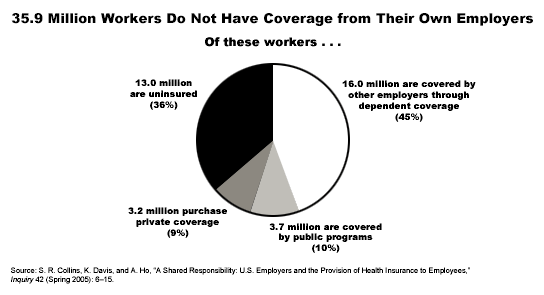Although employer-based health insurance forms the backbone of the U.S. health insurance system, it has been slowly eroding. Between 2000 and 2003, the number of Americans without health insurance coverage grew by 5 million, with nearly the entire increase attributed to a decline in employer-sponsored coverage.
When employers do not provide health insurance to their own employees, those workers' medical costs are met by other sources. A new study by researchers at The Commonwealth Fund finds that the largest part of these costs is paid for by other employers, who spend an estimated $31 billion to cover these workers through dependent coverage. That is in addition to the estimated $150 billion they spend on their own workers' health care costs.
In A Shared Responsibility: U.S. Employers and the Provision of Health Insurance to Employees (Inquiry, Spring 2005), the Fund's Sara R. Collins, Ph.D., Karen Davis, Ph.D., and Alice Ho explore the characteristics of workers who do not receive coverage from their own firms; examine how health care costs are spread across workers, employers, and the government; and recommend policy options to expand and strengthen employer-sponsored coverage.
Workers Without Job-Based Coverage
According to the 2001 Medical Expenditure Panel Survey, 35.9 million of 112.8 million working Americans do not have coverage from their employers at any time during the year. Most of these—22 million—lack coverage because their employers do not offer it to them, while 11.2 million are offered insurance but decline to take it. Nearly 13 million workers are uninsured and most of them, 9.5 million, were not offered coverage by their employers. Workers in small firms are at the greatest risk of lacking job-based coverage: just 44 percent of workers in establishments with fewer than 25 employees have health insurance through their jobs. However, millions of workers in large companies are also without coverage. More than one-quarter of employees in companies with 500 or more workers do not receive employer-based coverage, the authors say.
Low wages, in both small and large firms, is another known risk factor. Just 47 percent of workers earning less than $10 per hour have insurance from their companies, compared with 80 percent of those earning more than $15 per hour. Workers in low-income households also tend to have jobs without employer-sponsored coverage. About one-quarter (26%) of workers living in households with incomes under the federal poverty level have insurance through their companies, compared with three-quarters of workers with incomes above 400 percent of the poverty level. These workers lack access to other employer-based insurance, the authors say, either because they are the only worker in their household, other family members are without employer-sponsored coverage, or other family members' job-based insurance does not cover dependents. In all, nearly 70 percent of this group is outside the employer-based system.
Youth is also a risk factor for not having employer-sponsored coverage. Only 54 percent of workers ages 19 to 29 receive job-based coverage.
Worker Health Insurance Costs
Of an estimated $268 billion spent on health care for working adults, ages 19 to 64, in 2004, just over one-half ($150 billion) was provided by own-employer insurance, leaving $118 billion to be covered by other sources. These include employers that cover workers who are employed elsewhere ($31 billion), public programs ($8 billion), and other sources which include charity and bad debt ($13 billion). Workers, themselves, also pay a portion of these costs, either through out-of-pocket expenses ($58 billion) or private individual insurance premiums ($3 billion).
Health spending, per capita, varies widely by primary source of coverage. Not surprisingly, health spending is lower for the uninsured ($700) and those covered under other private insurance ($1,677). Out-of-pocket costs are higher for these groups, and consequently they likely use fewer services. In contrast, spending by workers who are covered by their own employer is higher—about $2,600 per year, of which $1,945 is covered by insurance.
Strategies to Strengthen Employer Coverage
If more major U.S. companies eliminate coverage, or make it less affordable by shifting more of their costs to employees in the form of higher deductibles, greater premium contributions or copayments, employer-sponsored coverage may continue to decline. Targeted policy strategies, however, could help curb this erosion and increase coverage for more Americans. One immediate strategy would be to provide tax credits or premium assistance to low-wage workers to make coverage more affordable. About 11 million workers are offered insurance but decline it; about 2.5 million of them are uninsured.
Another strategy, proposed by Senators John Kerry (D-Mass.) and Bill Frist (R-Tenn.), is to reduce and stabilize premiums for smaller firms through reinsurance or stop-loss coverage. New York State's Healthy New York program, which has successfully enrolled about 123,000 people since it began in 2001, uses this strategy to provide lower premiums for small employers. A third strategy involves creating larger purchasing pools—a parallel to the Federal Employees Health Benefits Program, for example—for small businesses to get better premiums and benefits, as well as more choices.
There are many incremental changes, as well, that employers could make to improve coverage, like covering young adults under their parents' policies up to age 23 or 25, whether or not they are full-time college students; limiting waiting periods for new employees; and continuing coverage for employees for two months after termination of employment. "Policy options like these, designed to strengthen the employer-based system," say the authors, "would help stem the rising tide of uninsured Americans and spread the costs of coverage more equitably across workers, employers, and government."
